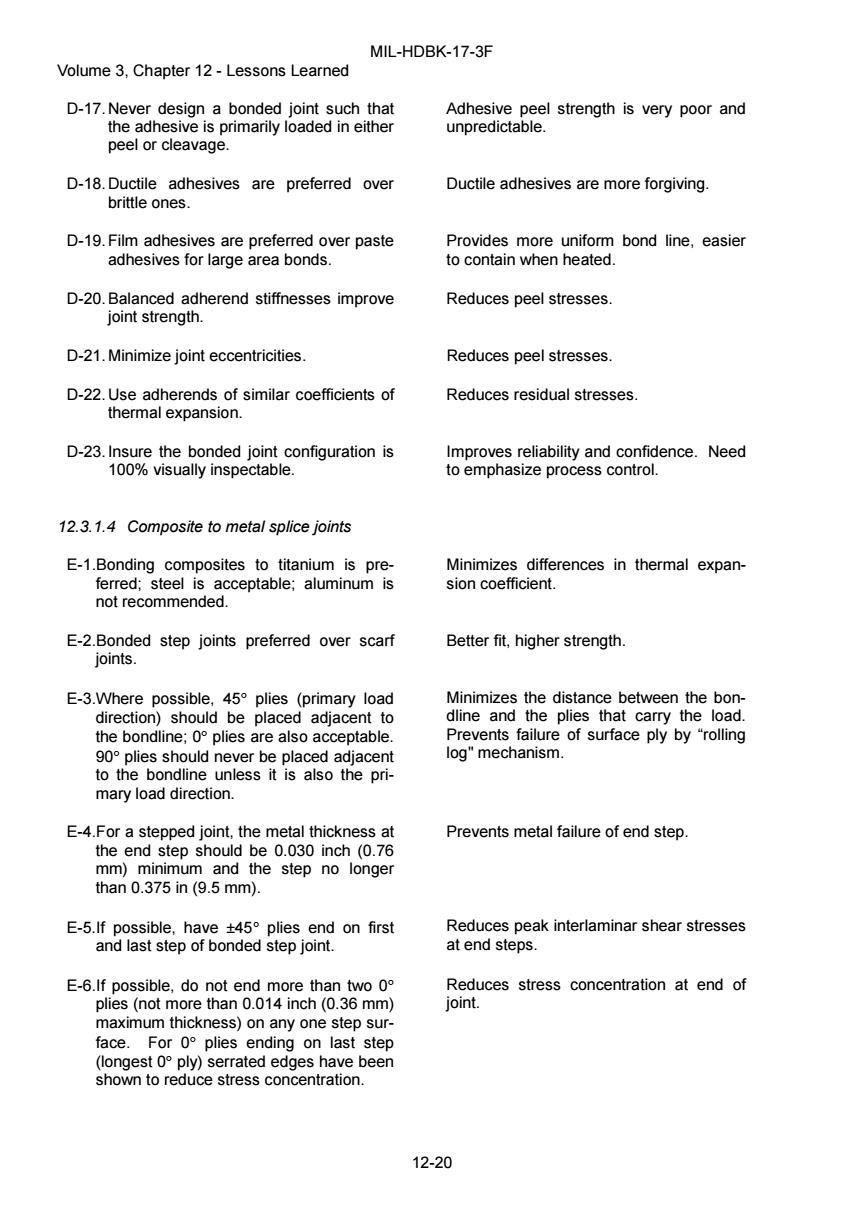正在加载图片...

MIL-HDBK-17-3F Volume 3,Chapter 12-Lessons Learned D-17.Never design a bonded joint such that Adhesive peel strength is very poor and the adhesive is primarily loaded in either unpredictable. peel or cleavage. D-18.Ductile adhesives are preferred over Ductile adhesives are more forgiving. brittle ones D-19.Film adhesives are preferred over paste Provides more uniform bond line,easier adhesives for large area bonds. to contain when heated D-20.Balanced adherend stiffnesses improve Reduces peel stresses. joint strength. D-21.Minimize joint eccentricities. Reduces peel stresses. D-22.Use adherends of similar coefficients of Reduces residual stresses. thermal expansion. D-23.Insure the bonded joint configuration is Improves reliability and confidence.Need 100%visually inspectable. to emphasize process control. 12.3.1.4 Composite to metal splice joints E-1.Bonding composites to titanium is pre- Minimizes differences in thermal expan- ferred:steel is acceptable;aluminum is sion coefficient. not recommended. E-2.Bonded step joints preferred over scarf Better fit,higher strength. joints. E-3.Where possible,45 plies (primary load Minimizes the distance between the bon- direction)should be placed adjacent to dline and the plies that carry the load. the bondline;0 plies are also acceptable. Prevents failure of surface ply by "rolling 90 plies should never be placed adjacent log"mechanism. to the bondline unless it is also the pri- mary load direction. E-4.For a stepped joint,the metal thickness at Prevents metal failure of end step the end step should be 0.030 inch(0.76 mm)minimum and the step no longer than 0.375 in (9.5 mm). E-5.If possible,have±45°plies end on first Reduces peak interlaminar shear stresses and last step of bonded step joint at end steps E-6.If possible,do not end more than two 0 Reduces stress concentration at end of plies (not more than 0.014 inch(0.36 mm) joint. maximum thickness)on any one step sur- face.For 0 plies ending on last step (longest 0 ply)serrated edges have been shown to reduce stress concentration. 12-20MIL-HDBK-17-3F Volume 3, Chapter 12 - Lessons Learned 12-20 D-17. Never design a bonded joint such that the adhesive is primarily loaded in either peel or cleavage. Adhesive peel strength is very poor and unpredictable. D-18. Ductile adhesives are preferred over brittle ones. Ductile adhesives are more forgiving. D-19. Film adhesives are preferred over paste adhesives for large area bonds. Provides more uniform bond line, easier to contain when heated. D-20. Balanced adherend stiffnesses improve joint strength. Reduces peel stresses. D-21. Minimize joint eccentricities. Reduces peel stresses. D-22. Use adherends of similar coefficients of thermal expansion. Reduces residual stresses. D-23. Insure the bonded joint configuration is 100% visually inspectable. Improves reliability and confidence. Need to emphasize process control. 12.3.1.4 Composite to metal splice joints E-1.Bonding composites to titanium is preferred; steel is acceptable; aluminum is not recommended. Minimizes differences in thermal expansion coefficient. E-2.Bonded step joints preferred over scarf joints. Better fit, higher strength. E-3.Where possible, 45° plies (primary load direction) should be placed adjacent to the bondline; 0° plies are also acceptable. 90° plies should never be placed adjacent to the bondline unless it is also the primary load direction. Minimizes the distance between the bondline and the plies that carry the load. Prevents failure of surface ply by “rolling log" mechanism. E-4.For a stepped joint, the metal thickness at the end step should be 0.030 inch (0.76 mm) minimum and the step no longer than 0.375 in (9.5 mm). Prevents metal failure of end step. E-5.If possible, have ±45° plies end on first and last step of bonded step joint. Reduces peak interlaminar shear stresses at end steps. E-6.If possible, do not end more than two 0° plies (not more than 0.014 inch (0.36 mm) maximum thickness) on any one step surface. For 0° plies ending on last step (longest 0° ply) serrated edges have been shown to reduce stress concentration. Reduces stress concentration at end of joint